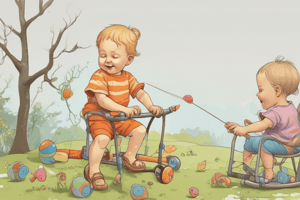Podcast
Questions and Answers
Who are better suited for unstructured play that leads to sustained attention?
Who are better suited for unstructured play that leads to sustained attention?
- Siblings
- Fathers
- Mothers
- Peers (correct)
What aspect of maternal behavior at 13 and 21 months maximizes attentiveness and interest in playing?
What aspect of maternal behavior at 13 and 21 months maximizes attentiveness and interest in playing?
- Maternal responsiveness (correct)
- Maternal influence on social stimuli
- Encouragement of orientation
- Stimulation and responsiveness
What type of play is better for maintaining mutual interest and excitement in joint activities?
What type of play is better for maintaining mutual interest and excitement in joint activities?
- Play with siblings
- Unstructured play with peers (correct)
- Unstructured play with parents
- Structured play
What does Vygotsky suggest about play?
What does Vygotsky suggest about play?
What predicts persistence during problem solving at 13 months?
What predicts persistence during problem solving at 13 months?
Which type of play promotes a flexible mindset and divergent thinking?
Which type of play promotes a flexible mindset and divergent thinking?
Which type of play is associated with complex language use and language development?
Which type of play is associated with complex language use and language development?
Which type of play supports the simulation of real-world scenarios?
Which type of play supports the simulation of real-world scenarios?
Which type of play conveys cultural principles and values?
Which type of play conveys cultural principles and values?
Which type of play is controlled by siblings initially, but by age 2 or 3, they support symbolic play?
Which type of play is controlled by siblings initially, but by age 2 or 3, they support symbolic play?
Which type of play is linked to innovativeness and flexible problem-solving?
Which type of play is linked to innovativeness and flexible problem-solving?
Who primarily engages in nurturing and household themes when playing with daughters?
Who primarily engages in nurturing and household themes when playing with daughters?
What type of play is characterized by basic manipulation of objects as an exploratory activity?
What type of play is characterized by basic manipulation of objects as an exploratory activity?
Which function of play is supported by adult caregivers?
Which function of play is supported by adult caregivers?
When do peers take on a greater role in play than caregivers and siblings?
When do peers take on a greater role in play than caregivers and siblings?
What do adults use play to teach children?
What do adults use play to teach children?
Who plays an important role in promoting symbolic play in their younger siblings?
Who plays an important role in promoting symbolic play in their younger siblings?
What type of play in infancy involves manipulating one object at a time before exploring the parts of objects or how objects relate to each other?
What type of play in infancy involves manipulating one object at a time before exploring the parts of objects or how objects relate to each other?
At what age does symbolic play typically emerge in children according to the text?
At what age does symbolic play typically emerge in children according to the text?
Which type of play involves pretending with objects about events or experiences that are not physically present?
Which type of play involves pretending with objects about events or experiences that are not physically present?
Which type of play is characterized by using objects alone, in combinations, and in sequences to pretend about events or past experiences?
Which type of play is characterized by using objects alone, in combinations, and in sequences to pretend about events or past experiences?
What distinguishes symbolic play from exploratory play in infants?
What distinguishes symbolic play from exploratory play in infants?
What distinguishes exploratory play from inappropriate combinational activity?
What distinguishes exploratory play from inappropriate combinational activity?
In symbolic play, what characterizes other-directed pretense?
In symbolic play, what characterizes other-directed pretense?
What defines Sequential pretense in symbolic play?
What defines Sequential pretense in symbolic play?
During the Intrapsychological Mastery function of play, what is the main role of the caregiver?
During the Intrapsychological Mastery function of play, what is the main role of the caregiver?
What characterizes the Transitional Play stage in pretend play?
What characterizes the Transitional Play stage in pretend play?
Why do infants aged 17 months to 3 years smile more with siblings and older infants than with their mom?
Why do infants aged 17 months to 3 years smile more with siblings and older infants than with their mom?
Flashcards are hidden until you start studying




